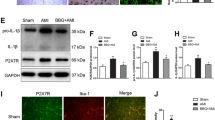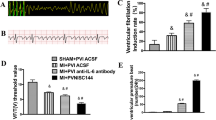Abstract
Findings from our laboratory indicate that proinflammatory cytokines and their transcription factor, nuclear factor-kappaB (NF-κB), are increased in the hypothalamic paraventricular nucleus (PVN) and contribute towards the progression of heart failure. In this study, we determined whether NF-κB activation within the PVN contributes to sympathoexcitation via interaction with neurotransmitters in the PVN during the pathogenesis of heart failure. Heart failure was induced in rats by left anterior descending coronary artery ligation. Sham-operated control (SHAM) or heart failure rats were treated for 4 weeks through bilateral PVN infusion with SN50, SN50M or vehicle via osmotic minipump. Rats with heart failure treated with PVN vehicle or SN50M (inactive peptide for SN50) had increased levels of glutamate, norepinephrine (NE), tyrosine hydroxylase (TH), superoxide, gp91phox (a subunit of NAD(P)H oxidase), phosphorylated IKKβ and NF-κB p65 activity, and lower levels of gamma-aminobutyric acid (GABA) and the 67-kDa isoform of glutamate decarboxylase (GAD67) in the PVN compared with those of SHAM rats. Plasma levels of cytokines, norepinephrine, epinephrine and angiotensin II, and renal sympathetic nerve activity (RSNA) were increased in heart failure rats. Bilateral PVN infusion of SN50 prevented the decreases in PVN GABA and GAD67, and the increases in RSNA and PVN glutamate, norepinephrine, TH, superoxide, gp91phox, phosphorylated IKKβ and NF-κB p65 activity observed in vehicle or SN50M-treated heart failure rats. A same dose of SN50 given intraperitoneally did not affect neurotransmitters concentration in the PVN and was similar to vehicle-treated heart failure rats. These findings suggest that NF-κB activation in the PVN modulates neurotransmitters and contributes to sympathoexcitation in rats with ischemia-induced heart failure.







Similar content being viewed by others
References
Agarwal D, Haque M, Sriramula S, Mariappan N, Pariaut R, Francis J (2009) Role of proinflammatory cytokines and redox homeostasis in exercise-induced delayed progression of hypertension in spontaneously hypertensive rats. Hypertension 54:1393–1400. doi:10.1161/HYPERTENSIONAHA.109.135459
Aker S, Belosjorow S, Konietzka I, Duschin A, Martin C, Heusch G, Schulz R (2003) Serum but not myocardial TNF-alpha concentration is increased in pacing-induced heart failure in rabbits. Am J Physiol Regul Integr Comp Physiol 285:463–469. doi:10.1152/ajpregu.00153.2003
Barber M, Kasturi BS, Austin ME, Patel KP, MohanKumar SM, MohanKumar PS (2003) Diabetes-induced neuroendocrine changes in rats: role of brain monoamines, insulin and leptin. Brain Res 964:128–135. doi:10.1016/S0006-8993(02)04091-X
Bhakar AL, Tannis LL, Zeindler C, Russo MP, Jobin C, Park DS, MacPherson S, Barker PA (2002) Constitutive nuclear factor-kappa B activity is required for central neuron survival. J Neurosci 22:8466–8475. doi:0270-6474/02/228466-10
Chappell D, Hofmann-Kiefer K, Jacob M, Rehm M, Briegel J, Welsch U, Conzen P, Becker BF (2009) TNF-alpha induced shedding of the endothelial glycocalyx is prevented by hydrocortisone and antithrombin. Basic Res Cardiol 104:79–89. doi:10.1007/s00395-008-0749-5
Chorianopoulos E, Heger T, Lutz M, Frank D, Bea F, Katus HA, Frey N (2010) FGF-inducible 14-kDa protein (Fn14) is regulated via the RhoA/ROCK kinase pathway in cardiomyocytes and mediates nuclear factor-kappaB activation by TWEAK. Basic Res Cardiol 105:301–313. doi:10.1007/s00395-009-0046-y
Cowling RT, Gurantz D, Peng J, Dillmann WH, Greenberg BH (2002) Transcription factor NF-kappa B is necessary for up-regulation of type 1 angiotensin II receptor mRNA in rat cardiac fibroblasts treated with tumor necrosis factor-alpha or interleukin-1 beta. J Biol Chem 277:5719–5724. doi:10.1074/jbc.M107515200
Dunn AJ (2000) Cytokine activation of the HPA axis. Ann N Y Acad Sci 917:608–617. doi:10.1111/j.1749-6632.2000.tb05426.x
Elks CM, Mariappan N, Haque M, Guggilam A, Majid DS, Francis J (2009) Chronic NF-κB blockade reduces cytosolic and mitochondrial oxidative stress and attenuates renal injury and hypertension in SHR. Am J Physiol Renal Physiol 296:298–305. doi:10.1152/ajprenal.90628.2008
Ferrari R (1998) Tumor necrosis factor in CHF: a double facet cytokine. Cardiovasc Res 37:554–559. doi:10.1016/S0008-6363(97)00309-X
Francis J, Chu Y, Johnson AK, Weiss RM, Felder RB (2004) Acute myocardial infarction induces hypothalamic cytokine synthesis. Am J Physiol Heart Circ Physiol 286:H2264–H2271. doi:10.1152/ajpheart.01072.2003
Francis J, MohanKumar SM, MohanKumar PS (2000) Correlations of norepinephrine release in the paraventricular nucleus with plasma corticosterone and leptin after systemic lipopolysaccharide: blockade by soluble IL-1 receptor. Brain Res 867:180–187. doi:10.1016/S0006-8993(00)02311-8
Francis J, Weiss RM, Johnson AK, Felder RB (2003) Central mineralocorticoid receptor blockade decreases plasma TNF-alpha after coronary artery ligation in rats. Am J Physiol Regul Integr Comp Physiol 284:R328–R335. doi:10.1152/ajpregu.00376.2002
Francis J, Zhang ZH, Weiss RM, Felder RB (2004) Neural regulation of the proinflammatory cytokine response to acute myocardial infarction. Am J Physiol Heart Circ Physiol 287:H791–H797. doi:10.1152/ajpheart.00099.2004
Gao L, Wang W, Li YL, Schultz HD, Liu D, Cornish KG, Zucker IH (2005) Sympathoexcitation by central ANG II: roles for AT1 receptor upregulation and NAD(P)H oxidase in RVLM. Am J Physiol Heart Circ Physiol 288:H2271–H2279. doi:10.1152/ajpheart.00949.2004
Gloire G, Legrand-Poels S, Piette J (2006) NF-kappaB activation by reactive oxygen species: fifteen years later. Biochem Pharmacol 72:1493–1505. doi:10.1016/j.bcp2006.04.011
Guggilam A, Cardinale JP, Mariappan N, Sriramula S, Haque M, Francis J (2011) Central TNF inhibition results in attenuated neurohumoral excitation in heart failure: a role for superoxide and nitric oxide. Basic Res Cardiol 106:273–286. doi:10.1007/s00395-010-0146-8
Guggilam A, Haque M, Kerut EK, McIlwain E, Lucchesi P, Seghal I, Francis J (2007) TNF-alpha blockade decreases oxidative stress in the paraventricular nucleus and attenuates sympathoexcitation in heart failure rats. Am J Physiol Heart Circ Physiol 293:H599–H609. doi:10.1152/ajpheart.00286.2007
Guggilam A, Patel KP, Haque M, Ebenezer PJ, Kapusta DR, Francis J (2008) Cytokine blockade attenuates sympathoexcitation in heart failure: cross-talk between nNOS, AT-1R and cytokines in the hypothalamic paraventricular nucleus. Eur J Heart Fail 10:625–634. doi:10.1016/j.ejheart.2008.05.004
Kang YM, Zhang AQ, Zhao XF, Cardinale J, Elks C, Cao XM, Zhang ZW, Francis J (2011) Paraventricular nucleus corticotrophin releasing hormone contributes to sympathoexcitation via interaction with neurotransmitters in heart failure. Basic Res Cardiol 106(3):473–483. doi:10.1007/s00395-011-0155-2
Kang YM, He RL, Yang LM, Qin DN, Guggilam A, Elks C, Yan N, Guo Z, Francis J (2009) Brain tumour necrosis factor-alpha modulates neurotransmitters in hypothalamic paraventricular nucleus in heart failure. Cardiovasc Res 83:737–746. doi:10.1093/cvr/cvp160
Kang YM, Ma Y, Elks C, Zheng JP, Yang ZM, Francis J (2008) Cross-talk between cytokines and renin-angiotensin in hypothalamic paraventricular nucleus in heart failure: role of nuclear factor-kappaB. Cardiovasc Res 79:671–678. doi:10.1093/cvr/cvn119
Kang YM, Ma Y, Zheng JP, Elks C, Sriramula S, Yang ZM, Francis J (2009) Brain nuclear factor-kappa B activation contributes to neurohumoral excitation in angiotensin II-induced hypertension. Cardiovasc Res 82:503–512. doi:10.1093/cvr/cvp073
Kang YM, Zhang ZH, Johnson RF, Yu Y, Beltz T, Johnson AK, Weiss RM, Felder RB (2006) Novel effect of mineralocorticoid receptor antagonism to reduce proinflammatory cytokines and hypothalamic activation in rats with ischemia-induced heart failure. Circ Res 99:758–766. doi:10.1161/01.RES.0000244092.95152.86
Kang YM, Zhang ZH, Xue B, Weiss RM, Felder RB (2008) Inhibition of brain proinflammatory cytokine synthesis reduces hypothalamic excitation in rats with ischemia-induced heart failure. Am J Physiol Heart Circ Physiol 295:H227–H236. doi:10.1152/ajpheart.01157.2007
Kenney MJ, Weiss ML, Haywood JR (2003) The paraventricular nucleus: an important component of the central neurocircuitry regulating sympathetic nerveoutflow. Acta Physiol Scand 177(1):7–15. doi:10.1046/j.1365-201X.2003.01042.x
Kleinbongard P, Heusch G, Schulz R (2010) TNFalpha in atherosclerosis, myocardial ischemia/reperfusion and heart failure. Pharmacol Ther 127:295–314. doi:10.1016/j.pharmthera.2010.05.002
Li YF, Jackson KL, Stern JE, Rabeler B, Patel KP (2006) Interaction between glutamate and GABA systems in the integration of sympathetic outflow by the paraventricular nucleus of the hypothalamus. Am J Physiol Heart Circ Physiol 291:H2847–H2856. doi:10.1152/ajpheart.00625.2005
Lacerda L, McCarthy J, Mungly SF, Lynn EG, Sack MN, Opie LH, Lecour S (2010) TNFα protects cardiac mitochondria independently of its cell surface receptors. Basic Res Cardiol 105:751–762. doi:10.1007/s00395-010-0113-4
Li S, Zhong S, Zeng K, Luo Y, Zhang F, Sun X, Chen L (2010) Blockade of NF-kappaB by pyrrolidine dithiocarbamate attenuates myocardial inflammatory response and ventricular dysfunction following coronary microembolization induced by homologous microthrombi in rats. Basic Res Cardiol 105:139–150. doi:10.1007/s00395-009-0067-6
Lupia E, Spatola T, Cuccurullo A, Bosco O, Mariano F, Pucci A, Ramella R, Alloatti G, Montrucchio G (2010) Thrombopoietin modulates cardiac contractility in vitro and contributes to myocardial depressing activity of septic shock serum. Basic Res Cardiol 105:609–620. doi:10.1007/s00395-010-0103-6
Liu JL, Irvine S, Reid IA, Patel KP, Zucker IH (2000) Chronic exercise reduces sympathetic nerve activity in rabbits with pacing-induced heart failure: a role for angiotensin II. Circulation 102:1854–1862. doi:10.1161/01.CIR.102.15.1854
MohanKumar SM, MohanKumar PS, Quadri SK (1998) Specificity of interleukin-1beta-induced changes in monoamine concentrations in hypothalamic nuclei: blockade by interleukin-1 receptor antagonist. Brain Res Bull 47:29–34. doi:10.1016/S0361-9230(98)00037-9
Nagura S, Sakagami T, Kakiichi A, Yoshimoto M, Miki K (2004) Acute shifts in baroreflex control of renal sympathetic nerve activity induced by REM sleep and grooming in rats. J Physiol 558:975–983. doi:10.1113/jphysiol.2004.064527
Nozaki N, Yamaguchi S, Shirakabe M, Nakamura H, Tomoike H (1997) Soluble tumor necrosis factor receptors are elevated in relation to severity of congestive heart failure. Jpn Circ J 61:657–664. doi:10.1253/jcj.61.657
Paxinos G, Watson CR, Emson PC (1987) The rat brain in stereotaxic coordinates, 2nd edn. Academic, San Diego
Schulz R, Heusch G (2009) Tumor necrosis factor-alpha and its receptors 1 and 2: Yin and Yang in myocardial infarction? Circulation 119:1355–1357. doi:10.1161/CIRCULATIONAHA.108.846105
Skyschally A, Gres P, Hoffmann S, Haude M, Erbel R, Schulz R, Heusch G (2007) Bidirectional role of tumor necrosis factor-alpha in coronary microembolization: progressive contractile dysfunction versus delayed protection against infarction. Circ Res 100:140–146. doi:10.1161/01.RES.0000255031.15793.86
Swanson LW, Sawchenko PE (1980) Paraventricular nucleus: a site for the integration of neuroendocrine and autonomic mechanisms. Neuroendocrinology 31:410–417
Thielmann M, Dörge H, Martin C, Belosjorow S, Schwanke U, van De Sand A, Konietzka I, Büchert A, Krüger A, Schulz R, Heusch G (2002) Myocardial dysfunction with coronary microembolization: signal transduction through a sequence of nitric oxide, tumor necrosis factor-alpha, and sphingosine. Circ Res 90:807–813. doi:10.1161/01.RES.0000014451.75415.36
Valen G, Yan ZQ, Hansson GK (2001) Nuclear factor kappa-B and the heart. J Am Coll Cardiol 38:307–314. doi:10.1016/s0735-1097(01)01377-8
Yang LM, Hu B, Xia YH, Zhang BL, Zhao H (2008) Lateral habenula lesions improve the behavioral response in depressed rats via increasing the serotonin level in dorsal raphe nucleus. Behav Brain Res 188:84–90. doi:10.1016/j.bbr.2007.10.022
Zhang C, Wu J, Xu X, Potter BJ, Gao X (2010) Direct relationship between levels of TNF-alpha expression and endothelial dysfunction in reperfusion injury. Basic Res Cardiol 105:453–464. doi:10.1007/s00395-010-0083-6
Zhang ZH, Wei SG, Francis J, Felder RB (2003) Cardiovascular and renal sympathetic activation by blood-borne TNF-alpha in rat: the role of central prostaglandins. Am J Physiol Regul Integr Comp Physiol 284:R916–R927. doi:10.1152/ajpregu.00406.2002
Acknowledgments
This work was supported by National Natural Science Foundation of China (Nos. 81070199, 81170248, 81025001), U.S. National Institutes of Health (NIH) Grant RO1-HL-080544, and National Basic Research Program of China (Nos. 2012CB517805, 2007CB512106).
Conflict of interest
None declared.
Author information
Authors and Affiliations
Corresponding authors
Additional information
Y.-M. Kang, F. Gao and H.-H. Li contributed equally to this work.
Rights and permissions
About this article
Cite this article
Kang, YM., Gao, F., Li, HH. et al. NF-κB in the paraventricular nucleus modulates neurotransmitters and contributes to sympathoexcitation in heart failure. Basic Res Cardiol 106, 1087–1097 (2011). https://doi.org/10.1007/s00395-011-0215-7
Received:
Revised:
Accepted:
Published:
Issue Date:
DOI: https://doi.org/10.1007/s00395-011-0215-7




